History of Pembrokeshire
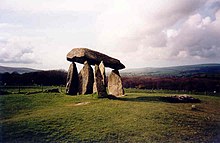
Human habitation of the region that is now Pembrokeshire, in southwest Wales, UK, extends back to between 125,000 and 70,000 years[1]: 3 and there are numerous prehistoric sites such as Pentre Ifan, and neolithic remains (12,000 to 6,500 years ago), more of which were revealed in an aerial survey during the 2018 heatwave;[2] in the same year, a 1st-century Celtic chariot burial was discovered in Llanstadwell, the first such find in Wales.[3][4] There may have been dairy farming in Neolithic times.[5]
Roman period
[edit]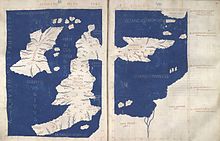
There is little evidence of Roman occupation in what is now Pembrokeshire. Ptolemy's Geography, written c. 150, mentioned some coastal places, two of which have been identified as the River Teifi and what is now St Davids Head, but most Roman writers did not mention the area; there may have been a Roman settlement near St Davids and a road from Bath, but this comes from a 14th-century writer. Any evidence for villas or Roman building materials reported by mediaeval or later writers has not been verified, though some remains near Dale were tentatively identified as Roman in character by topographer Richard Fenton in his Historical Tour of 1810. Fenton stated that he had "...reason to be of opinion that they had not colonized Pembrokeshire till near the decline of their empire in Britain".[6]: 144
Part of a possible Roman road is noted by CADW near Llanddewi Velfrey,[7] and another near Wiston.[8] Wiston is also the location of the first Roman fort discovered in Pembrokeshire, investigated in 2013.[9] A find in north Pembrokeshire in 2024 of the likely remains of a Roman fort adds to the extent of Roman military presence in the area.[10]
Some artefacts, including coins and weapons, have been found, but it is not clear whether these belonged to Romans or to a Romanised population. Welsh tradition has it that Magnus Maximus founded Haverfordwest, and took a large force of local men on campaign in Gaul in 383 which, together with the reduction of Roman forces in south Wales, left a defensive vacuum which was filled by incomers from Ireland.[11]: 37–51 [better source needed]
Sub-Roman period
[edit]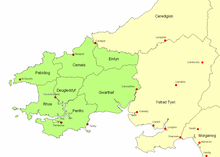
Between 350 and 400, an Irish tribe known as the Déisi settled in the region known to the Romans as Demetae.[1]: 52, 17, 30, 34 The Déisi merged with the local Welsh, with the regional name underlying Demetae evolving into Dyfed, which existed as an independent petty kingdom from the 5th century.[1]: 52, 72, 85, 87 In 904, Hywel Dda married Elen (died 943),[12] daughter of the king of Dyfed Llywarch ap Hyfaidd, and merged Dyfed with his own maternal inheritance of Seisyllwg, forming the new realm of Deheubarth ("southern district"). Between the Roman and Norman periods, the region was subjected to raids from Vikings, who established settlements and trading posts at Haverfordwest, Fishguard, Caldey Island and elsewhere.[1]: 81–85 [6]: 135–136
Norman period and Middle Ages
[edit]Dyfed remained an integral province of Deheubarth, but this was contested by invading Normans and Flemings who arrived between 1067 and 1111.[1]: 98 The region became known as Pembroke (sometimes archaic "Penbroke"[13]: 53–230 ), after the Norman castle built in the cantref of Penfro. In 1136, Prince Owain Gwynedd at Crug Mawr near Cardigan met and destroyed a 3,000-strong Norman/Flemish army and incorporated Deheubarth into Gwynedd.[14]: 80–85 [1]: 124 Norman/Flemish influence never fully recovered in West Wales.[15]: 79 In 1138, the county of Pembrokeshire was named as a county palatine. Rhys ap Gruffydd, the son of Owain Gwynedd's daughter Gwenllian, re-established Welsh control over much of the region and threatened to retake all of Pembrokeshire, but died in 1197. After Deheubarth was split by a dynastic feud, Llywelyn the Great almost succeeded in retaking the region of Pembroke between 1216 and his death in 1240.[1]: 106, 112, 114 In 1284 the Statute of Rhuddlan was enacted to introduce the English common law system to Wales,[16] heralding 100 years of peace, but had little effect on those areas already established under the Marcher Lords, such as Cemais in the north of the county.[17]: 123–124
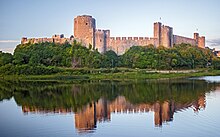
Henry Tudor, born at Pembroke Castle in 1457, landed an army in Pembrokeshire in 1485 and marched to Cardigan.[11]: 223 [better source needed] Rallying support, he continued to Leicestershire and defeated the larger army of Richard III at the Battle of Bosworth Field. As Henry VII, he became the first monarch of the House of Tudor, which ruled England until 1603.[18]: 337–379
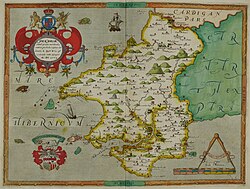
Tudor and Stuart periods
[edit]The Laws in Wales Act 1535 effectively abolished the powers of the Marcher Lords and divided the county into seven hundreds, roughly corresponding to the seven pre-Norman cantrefi of Dyfed.[11]: 247 [19] The hundreds were (clockwise from the northeast): Cilgerran, Cemais, Dewisland, Roose, Castlemartin, Narberth and Dungleddy and each was divided into civil parishes;[20] a 1578 map by Christopher Saxton is the earliest known to show parishes and chapelries in Pembrokeshire.[21] (See List of hundreds in Wales#Pembrokeshire for a list of parishes in medieval Pembrokeshire.) The Elizabethan era brought renewed prosperity to the county through an opening up of rural industries, including agriculture, mining and fishing, with exports to England and Ireland, though the formerly staple woollen industry had all but disappeared.[11]: 310
During the First English Civil War (1642–1646) the county gave strong support to the Roundheads (Parliamentarians), in contrast to the rest of Wales, which was staunchly Royalist. In spite of this, an incident in Pembrokeshire triggered the opening shots of the Second English Civil War when local units of the New Model Army mutinied. Oliver Cromwell defeated the uprising at the Siege of Pembroke in July 1648.[22]: 437–438 On 13 August 1649, the Cromwellian conquest of Ireland began when New Model Army forces sailed from Milford Haven.[23]
18th and 19th centuries
[edit]
In 1720, Emmanuel Bowen[24] described Pembrokeshire as having five market towns, 45 parishes and about 4,329 houses, with an area of 420,000 acres (1,700 km2). In 1791 a petition was presented to the House of Commons concerning the poor state of many of the county's roads, pointing out that repairs could not be made compulsory by the law as it stood. The petition was referred to committee.[25]: 178 People applying for poor relief were often put to work mending roads. Workhouses were poorly documented. Under the Poor Laws, costs and provisions were kept to a minimum, but the emphasis was often on helping people to be self-employed. While the Poor Laws provided a significant means of support, there were many charitable and benefit societies.[26] After the Battle of Fishguard, the failed French invasion of 1797, 500 French prisoners were held at Golden Hill Farm, Pembroke.[27] From 1820 to 1878 one of the county's prisons, with a capacity of 86, was in the grounds of Haverfordwest Castle.[28] In 1831, the area of the county was calculated to be 345,600 acres (1,399 km2) with a population of 81,424.[24]
It was not until nearly the end of the 19th century that mains water was provided to rural south Pembrokeshire by means of a reservoir at Rosebush and cast iron water pipes throughout the district.[29]
20th century
[edit]
Throughout much of the 20th century (1911 to 1961) the population density in the county remained stable while it rose in England and Wales as a whole.[30] There was considerable military activity in Pembrokeshire and offshore in the 20th century: a naval base at Milford Haven because German U-boats were active off the coast in World War I[31] and, in World War II, military exercises in the Preseli Mountains and a number of military airfields.[32] The wartime increase in air activity saw a number of aircraft accidents and fatalities, often due to unfamiliarity with the terrain.[33] From 1943 to 1944, 5,000 soldiers from the United States Army's 110th Infantry Regiment were based in the county, preparing for D-Day.[34][35] Military and industrial targets in the county were subjected to bombing during World War II.[36] After the end of the war, German prisoners of war were accommodated in Pembrokeshire, the largest prison being at Haverfordwest, housing 600.[37] The County of Pembroke War Memorial in Haverfordwest carries the names of 1,200 of those that perished in World War I.[38]
In 1972, a second reservoir for south Pembrokeshire, at Llys y Fran, was completed.[39]
References
[edit]- ^ a b c d e f g Davies, John (1994). A History of Wales. London: Penguin. ISBN 978-0-14-014581-6.
- ^ "Heatwave crop marks reveal 200 ancient sites in Wales". BBC News. 28 December 2018. Retrieved 29 December 2018.
- ^ "Pembrokeshire chariot burial finds ruled as treasure". BBC News. 31 January 2019. Retrieved 2 February 2019.
- ^ Huw Thomas (26 June 2019). "Late Iron Age chariot pieces found in Pembrokeshire". BBC News. Retrieved 26 June 2019.
- ^ Prior, Neil (12 August 2021). "Trellyffaint: Proof unearthed of Neolithic dairy farming in Pembrokeshire". BBC News. Retrieved 12 August 2021.
- ^ a b Fenton, Richard (1811). A historical tour through Pembrokeshire. London: Longman, Hurst, Rees, Orme & co.
- ^ Cadw. "Roman Road 300m East of Bryn Farm (PE472)". National Historic Assets of Wales.
- ^ "Roman road W of Carmarthen; Via Julia, possible features NE of Wiston (309510)". Coflein. RCAHMW. Retrieved 13 August 2019.
- ^ "Dyfed Archaeological Trust: Wiston Roman Fort". Archived from the original on 14 October 2013. Retrieved 13 August 2019.
- ^ Sarah Bowdidge. "New find hints Wales fully-integrated into Roman Britain". Retrieved 3 August 2024.
- ^ a b c d Laws, Edward (1888). The History of Little England Beyond Wales. London: George Bell.
- ^ "The Chronicle of the Princes". Archaeologia Cambrensis. 4. 10: 25. 1864. Retrieved 2 February 2019.
- ^ Pughe, William Owen (1799). Cambrian Register for the Year 1796, Vol. II. London: E & T Williams. Retrieved 7 May 2015.
- ^ Lloyd, J. E. (2004). A History of Wales: From the Norman Invasion to the Edwardian Conquest. New York: Barnes & Noble. ASIN B01FKW4P94.
- ^ Warner, Philip (1997). Famous Welsh Battles. New York: Barnes & Noble. ASIN B01K3MUPM2.
- ^ Francis Jones (1969). The Princes and Principality of Wales. University of Wales Press. ISBN 978-0-900768-20-0. Retrieved 2 March 2011.
- ^ Rees, David (1997). The son of prophecy: Henry Tudor's road to Bosworth (2nd., rev. ed.). London: J. Jones. ISBN 978-1-871083-01-9.
- ^ Davies, Norman (2000). The Isles – A History. London: Macmillan. ISBN 978-0-333-69283-7.
- ^ "Laws in Wales Act 1535 (repealed 21.12.1993) (c.26)". statutelaw.gov.uk. The National Archive. 2010. Retrieved 28 November 2016.
- ^ "Pembrokeshire Hundreds and Parishes". GENUKI: UK & Ireland Genealogy. Retrieved 16 October 2016.
- ^ "Penbrok comitat". British Library. Archived from the original on 27 September 2021. Retrieved 22 July 2024.
- ^ Royle, Trevor (2005). Civil War: The War of the Three Kingdoms 1638–1660. London: Abacus. ISBN 978-0-349-11564-1.
- ^ "Timelines: 1649". BCW Project. Retrieved 28 November 2016.
- ^ a b "Pembrokeshire". GENUKI: UK & Ireland Genealogy. Retrieved 28 January 2018.
- ^ Journals of the House of Commons. Vol. 46. London: HM Stationery Office. 1803. Retrieved 17 May 2015.
- ^ Hancock, Simon (9 December 2016). "Aspects of the Old Poor Law". Pembrokeshire Historical Society. Retrieved 13 February 2018.
- ^ "Golden Hill Prison (412561)". Coflein. RCAHMW. Retrieved 13 February 2018.
- ^ "Pembrokeshire council to sell old Haverfordwest prison". BBC News. 9 July 2010. Retrieved 13 February 2018.
- ^ "Pembroke Borough Waterworks". The Pembrokeshire Herald. 14 April 1882. Retrieved 20 July 2019.
- ^ "Current rate: Population Density (Persons per Acre)". visionofbritain.org.uk. A Vision of Britain through Time. Pembrokeshire. Retrieved 1 February 2018.
- ^ "Pembrokeshire's front line role in the U-boat war". Western Telegraph. 12 November 2018. Retrieved 13 November 2018.
- ^ Thomas, Roger, ed. (2013). A Guide to the Military Heritage of Pembrokeshire. Compiled by local historians. Planed. Retrieved 22 June 2014.
- ^ "Military aircraft crash sites in south-west Wales" (PDF). Dyfed Archaeological Trust. Archived from the original (PDF) on 23 September 2015. Retrieved 5 May 2019.
- ^ "Pembrokeshire memorial plan for US D-Day servicemen". BBC News. 19 March 2019. Retrieved 19 March 2019.
- ^ "D-Day: Pembrokeshire memorial unveiled for US soldiers". BBC News. 22 October 2019. Retrieved 23 October 2019.
- ^ "Air Raids". Pembrokeshire Virtual Museum. Archived from the original on 12 December 2014. Retrieved 12 December 2014.
- ^ "German Prisoners of War in Pembrokeshire". Western Telegraph. 19 November 2013. Retrieved 13 February 2018.
- ^ "Pembrokeshire Historical Society: The story behind the Pembrokeshire County Great War Monument at Haverfordwest". 12 December 2016. Retrieved 19 February 2021.
- ^ "Llys y Fran Reservoir and Country Park". Archived from the original on 14 January 2019. Retrieved 4 July 2014.
